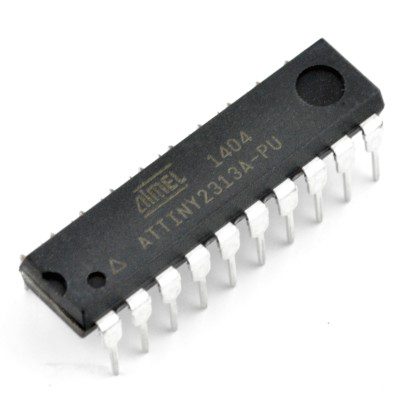Table of Contents:
ATtiny2313 is an advanced 8-bit microcontroller that belongs to the AVR family. The device is manufactured by Microchip, which acquired Atmel. The microcontroller’s design is based on CMOS technology, which makes it stand out for its low power consumption. This means that it is ideal for mobile solutions and battery-operated applications where energy efficiency is key. The integrated RISC (Reduced Instruction Set Computer) architecture allows for fast data processing, as most operations are performed in a single clock cycle. What else is worth knowing about the ATtiny2313? How is it built and what are its electrical parameters?
Basic information about the ATtiny2313 microcontroller
The ATtiny2313 offers a number of built-in peripheral functions, such as timers, communication interfaces (USART, USI) that allow easy connection to other chips in the system. Integrated power-saving features, including various sleep modes, reduce power consumption to a minimum. This makes the ATtiny2313 not only efficient, but also economical for long-term operation on limited power sources.
Construction of the ATtiny2313 microcontroller
The CPU in the ATtiny2313 is a powerful microprocessor based on AVR architecture, which is characterized by simplicity and high efficiency due to the use of RISC architecture. The CPU contains 32 general-purpose working registers, which enables simultaneous processing of multiple operations and instructions in a single clock cycle.
- The ATtiny2313 is equipped with 2 KB of Flash memory, which serves as the main memory for storing the device’s program. The Flash memory is reprogrammable, and the programming is done via ISP ( In-System Programming). This means easy firmware updates without having to remove the microcontroller from the application.
- The 128 bytes of EEPROM in the ATtiny2313 allows for permanent storage of data that will not be lost when the power is turned off. This is particularly useful for storing device configuration, user parameters or other data that must be retained between power cycles.
- The ATtiny2313 has 128 bytes of SRAM memory, which is used to store variables and the software stack while the microcontroller is running. SRAM provides very fast access to data. This is essential for real-time tasks.
- The microcontroller has two timers, a 16-bit timer and an 8-bit timer. The timers can be used for timing, generating PWM signals and performing tasks that require timing, such as time delays and sampling rates.
Other construction elements
- An internal calibrated oscillator provides stable timing for the microcontroller. The ability to select different frequencies allows performance and power consumption to be tailored to the specific needs of the application.
- The 18 I/O lines with optional internal pull-up resistors provide flexibility for connections to other circuits and modules. These I/O ports can be configured to support various functions such as digital inputs, digital outputs, interfaces for sensors, control of actuators, etc.
- The Universal Synchronous and Asynchronous Serial Transmitter-Receiver (USART) allows the ATtiny2313 to communicate serially with other microcontrollers, computers or peripherals.
- Universal Serial Interface (USI) facilitates the implementation of simple bidirectional communication interfaces such as SPI, I2C.
Electrical parameters of the ATtiny2313 microcontroller
The ATtiny2313 operates from 2.7 V to 5.5 V, making it suitable for a wide range of commercial and industrial applications.
- The microcontroller supports clocking from 0 to 4 MHz at low voltage (1.8 V) and up to 10 MHz in the higher voltage range (2.7 V to 5.5 V).
- The ATtiny2313 can be clocked at up to 10 MHz at 2.7 V and up to 20 MHz at 4.5 V to 5.5 V. These values provide flexibility in managing performance and power consumption.
- The microcontroller in active mode consumes 230 µA at 1 MHz and 1.8 V and only 20 µA at 32 kHz.
- In power-down mode, consumption drops to less than 0.1 µA at 1.8 V.
- In addition, power-down mode minimizes power consumption by stopping the oscillator and most of the chip’s functions, while preserving the memory contents.
- In Standby mode, the oscillator remains active while the rest of the circuit is asleep. This means that it can quickly resume operation.
- In Idle power-saving mode, the microcontroller halts the processor while allowing SRAM, timers and the interrupt system to operate.
- Programmable voltage drop detection ( Brown-out Detection) protects the circuit from abnormal operation caused by insufficient supply voltage.
Applications of the ATtiny2313 microcontroller
The ATtiny2313 microcontroller is a versatile chip with diverse applications.
- The ATtiny2313 is used in simple embedded systems thanks to its ability to operate in low-voltage and low-power applications. It is ideal for controlling devices such as sensors, LED displays and other electronic components in everyday devices.
- Due to its low cost and relatively simple programming, the ATtiny2313 is a popular choice for electronic toy manufacturers. It can control mechanisms, light and sound effects in devices designed for play.
- In addition, the microcontroller is used in smart home devices such as lighting management systems, thermostats and other automation support equipment and control systems.
- ATtiny2313 is used in alarm and monitoring systems, where it is responsible for processing sensor signals, managing alarms and communicating with the control panel.
Other applications of the microcontroller
With the ability to configure multiple input/output lines, the microcontroller is used to create user interfaces such as keyboards, touch panels and other input devices in electronic equipment. In industry, on the other hand, the ATtiny2313 controls simple machines or can be part of larger modular systems.
How useful was this post?
Click on a star to rate it!
Average rating 5 / 5. Vote count: 1
No votes so far! Be the first to rate this post.




















